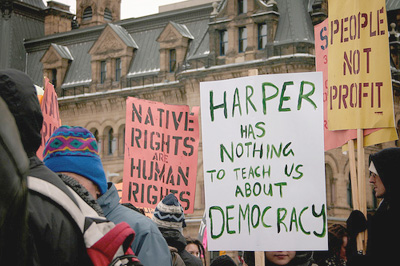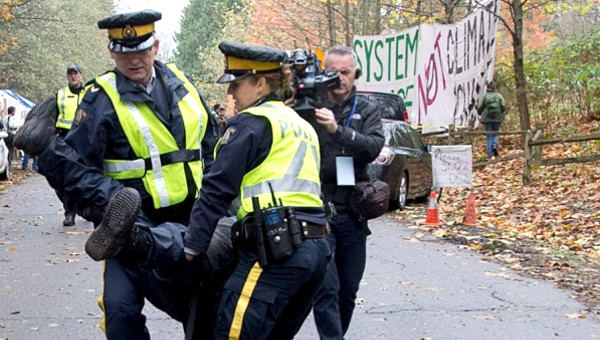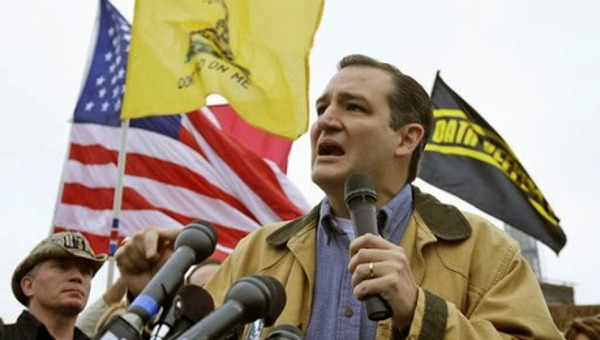Internal documents from Indian Affairs and the Royal Canadian Mounted Police (RCMP) show that shortly after forming government in January of 2006, Prime Minister Stephen Harper had the federal government tighten up on gathering and sharing intelligence on First Nations to anticipate and manage potential First Nation unrest across Canada.
Information obtained by Access to Information requests reveals that almost immediately upon taking power in 2006, the Department of Indian and Northern Affairs Canada (INAC) was given the lead role to spy on First Nations. The goal was to identify the First Nation leaders, participants and outside supporters of First Nation occupations and protests, and to closely monitor their actions.
 To accomplish this task, INAC established a “Hot Spot Reporting System.” These weekly reports highlight all those communities across the country who engage in direct action to protect their lands and communities. They include Tobique First Nation, Tsartlip First Nation, the Algonquins of Barriere Lake, Teztan Biny (Fish Lake) First Nation, Six Nations, Grassy Narrows, Stz’uminous First Nation, the Likhts’amsiyu Clan of the Wet’suwet’en First Nation, Gitxaala First Nation, Wagmatcook First Nation, Innu of Labrador, Pikangikum First Nation, and many more. They include bands from the coast of Vancouver Island to the shores of the Atlantic Ocean.
To accomplish this task, INAC established a “Hot Spot Reporting System.” These weekly reports highlight all those communities across the country who engage in direct action to protect their lands and communities. They include Tobique First Nation, Tsartlip First Nation, the Algonquins of Barriere Lake, Teztan Biny (Fish Lake) First Nation, Six Nations, Grassy Narrows, Stz’uminous First Nation, the Likhts’amsiyu Clan of the Wet’suwet’en First Nation, Gitxaala First Nation, Wagmatcook First Nation, Innu of Labrador, Pikangikum First Nation, and many more. They include bands from the coast of Vancouver Island to the shores of the Atlantic Ocean.
What we see in these documents – from the hot spot reports themselves, to the intelligence-sharing between government and security forces – is a closely monitored population of First Nations, who clearly are causing a panic at the highest levels of Canadian bureaucracy and political office.
Fear of Aboriginal Hot Spots
In 2006, INAC gave the name “hot spots” to those First Nations conflicts of “growing concern” due to “unrest” and increasing “militancy.” In a briefing presentation that INAC gave the RCMP that year, these hot spots were identified as:
- Caledonia, Ontario: Douglas Creek Estates occupation;
- Belleville, Ontario: Montreal/Toronto Rail Blockade in sympathy to Caledonia;
- Brantford, Ontario: Grand River Conservation Authority Lands;
- Desoronto, Ontario: Occupation of Quarry;
- Grassy Narrows: Blockade of Trans Canada Hwy by environmentalists;
- Maniwaki, Quebec: Blockade of Route 117
But the “hot spot binder” prepared each week by INAC officials closely monitors any and all action taking place across the country and names dozens more communities as sources of potential unrest. A particular concern of the federal government is that these “hot spots” are unpredictable protests because they are led by what the federal government labels as “splinter groups” of “Aboriginal Extremists.” As INAC describes in the same presentation to the RCMP:
“Incidents led by splinter groups are arguably harder to manage as they exist outside negotiation processes to resolve recognized grievances with duly elected leaders. We seek to avoid giving standing to such splinter groups so as not to debase the legally recognized government. Incidents are also complicated by external groups such as Warrior Societies or non-Aboriginal counter-protest groups.”
Telling in the INAC statement above is that the identified protests are “outside of negotiation processes” with elected councils. Canada is clearly spooked by the specter of First Nations demanding Crown recognition of Indigenous sovereignty and self-determination, as well as Aboriginal and Treaty Rights, beyond the narrow confines of Crown land claims and self-government policies. These so-called “splinter” groups also threaten the status quo by demanding their own First Nation leaders, staff and advisors to pull out of the compromising negotiations.
Also telling here is the cozy cooperative relationship between INAC and the RCMP. The INAC briefing to the RCMP is almost indistinguishable from a presentation one would expect to see from security forces, rather than from a government ministry. Contrary to their claims, Indian Affairs is not an institution of reconciliation and negotiation, but rather appears to be a management office to control the costs of Native unrest, and they are willing to work closely with law enforcement to accomplish this task.
In addition to the hot spot reporting, the Deputy Ministers of Public Safety Emergency Preparedness Canada and INAC directed that a summer operational plan be prepared in 2006 to deal with Aboriginal occupations and protests. A progress report on the operational plan reveals the blueprint for security integration on First Nations issues.
The “Standing Information Sharing Forum,” for example, is chaired by the RCMP and includes as its members the Canadian Security Intelligence Service (CSIS), the Department of Fisheries, Government of Canada, Natural Resources Canada, Transportation Canada, and involves weekly conference calls and continuous information dissemination by INAC to its partners.
Harper is moving toward a security paradigm familiar since the War on Terror was launched in 2001. The inclusion of Transportation Canada at the Information Sharing Forum should also alert us to the commercial threat of blockades to the free trade agenda.
Aboriginal people who are defending their lands are now treated on a spectrum from criminals to terrorists. On either side, under Harper, an intensification of intelligence gathering and surveillance procedures now govern the new regime.
Haudenosaunee/Six Nations Iroquois Confederacy
It is also clear from INAC’s presentation to the RCMP that they are particularly worried about the Haudenosaunee/Six Nations Iroquois Confederacy. They mention “Warrior Societies” and an “illicit agenda,” referring at several points to concerns around smuggling. The federal government deems the tobacco/cigarette trade as “illicit” because Canada is not getting paid taxes by the Mohawks who are operating the businesses.
However, the 1995 federal Aboriginal Self-Government policy, which was developed unilaterally by the federal government, does not allow for sharing jurisdiction with First Nations for real powers over trade and commerce matters. The federal self-government policy only allows small business operations on-reserve. Historically, the federal government has used the Indian Act to control and manage on-reserve economic development so there was no real competition with surrounding non-Indian businesses and towns. On the prairies, First Nations agriculture was undermined and led to the failure of farming on-reserve because of complaints from non-Indians. This policy of non-competition is still the reality today.
The federal government is particularly concerned about the Haudenosaunee/Six Nations Iroquois Confederacy actions at Caledonia, as the INAC 2006 report describes it: “Caledonia was and remains a significant event in risk management.” The RCMP agree. In a 2007 report to CSIS, they state: “Caledonia continues to serve as a beacon on land claims and Aboriginal rights issues across Canada.”
Canada is extremely worried about First Nations taking back lands and resources outside the scope of their one-sided land claims and self-government “negotiation processes” as was done at Kanenhstaton/Caledonia. In order to contain the situation, the Crown governments have dispatched hard-nosed, experienced negotiators who have presented unmovable positions from the Harper government, which is likely why there hasn’t been any negotiated resolution of the situation at Kanenhstaton/Caledonia to this date. The Crown government obviously remain worried more lands will be ‘occupied’ by the Six Nations ‘extremist splinter groups.’
Ever since the 1990 stand-off in Kanesatake and Kahnawake, the federal government, the security and police agencies, and the Canadian army have been worried about a repeat of coordinated First Nation political actions across Canada.
The 2007 National Day Of Action
Specific information about policing First Nations was obtained in a series of Access to Information requests about the AFN National Day of Action that took place on June 29th, 2007. A 2007 RCMP brief to CSIS lays out a number of concerns regarding the National Day of Action.
First of all, the RCMP is mainly concerned about protecting their men and women in uniform, both from the perspective of First Nations confronting the police on front lines, and from the perspective of negative public sentiment for their potential handling of the event: “The often disparate and fractured nature of these events can lead the police to become the proverbial ‘meat in the sandwich’ and the subject of negative public sentiment.”
The RCMP also show concern that a lack of coordination, or “a fractured and inconsistent approach” by police forces, could “galvanize Nations throughout Canada.” Is this to say that violence instigated by police could lead to solidarity actions by First Nations across the country? Or that perceived weakness in policing could lead other First Nations to take a stand? Either way, in response, cooperation between departments, security forces, and ministries are deemed to be necessary to provide a strong united front against First Nations protest.
The RCMP also caution that, “Aboriginal and non-Aboriginal extremists often see these events as an opportunity to escalate or agitate the conflict.” By inference, we can guess that they may be referring to groups unaffiliated with the Assembly of First Nations (AFN), unwilling to negotiate under Crown policies, or prepared to engage in tactics not sanctioned by the official leadership, such as property destruction and armed conflict. Non-Aboriginal groups are also cited here as potentially threatening, giving credence to recent targeting of G20 “ringleaders” who feel their Indigenous solidarity work has made them targets of the Crown and police forces.
Cost is a serious concern to the RCMP, as well. Not only is the price tag for policing these nation-wide events “exorbitant,” and therefore can lead to rash policing decisions to use force in order to bring a quick end to conflicts, but the economic risks of blockades are themselves potentially catastrophic. As the RCMP warn, “The recent CN strike represents the extent in which a national railway blockade could effect the economy of Canada.”
“Clearly, where the distinction slips between police and policy roles, the RCMP become simply Indian Agents, carrying out the colonial work of the department.”
The RCMP also express this curious concern: “The police role may be complicated by the conventional and sometimes political view that there is a clear distinction between policy and police operations.” Clearly, where the distinction slips between police and policy roles, the RCMP become simply Indian Agents, carrying out the colonial work of the department. Given the information disclosed here, this distinction is impossible to maintain. Where police intimidate and arrest Indigenous peoples on their own lands, there is no law on the police’s side.
There is also a considerable public relations issue at stake here. The RCMP displayed concern at the potential fall-out of a number of “perception” problems that could befall the forces:
“Perception of a two-tiered approach to enforcement can generate significant criticism and motivate non-Aboriginal activists.
“An intense and protracted event may lead to long-standing erosion of relationships for the police and the community – they are usually always the victims.
“Because there are limitations on what the police can negotiate and success often depends on others, the role of the police can become frustrating.”
The RCMP realize to some extent that they must choose between First Nations approval of their policing tactics and the wrath of a public convinced that blockades are criminal, rather than political acts. The police, however, contrary to their assertions, are not the victims here. They are just the dupes in a much older game of cowboys and Indians.
The above RCMP statements show that even with all of the federal financial and managerial control over First Nation Chiefs and Leaders, except, apparently for the former AFN National Chief, Phil Fontaine, the Chiefs and Leaders were still not entirely trusted by the federal government and that a large concern in 2007 was the potential for a broad national coordinated series of local and regional political actions by First Nations.
One insight emerges strongly here: most threatening of all to security and government forces is coordinated First Nations action. This can be seen clearly from the reports. At one point in the 2007 INAC to RCMP briefing, concern is expressed about a First Nations conference because, “The 2006 Numbered Treaty Conference proposed a ‘national’ movement of independent actions to express discontent.”
Their fear is palpable where they follow the trajectory of the Day of Action from Chief Terrance Nelson’s proposal at the Assembly of First Nations, where the motion carried, to confirmation of the nation-wide event in a personal meeting between the RCMP Commissioner and Phil Fontaine, then National Chief, where “Mr. Fontaine expressed his concern over the sense of frustration that seems to exist among First Nation leaders and the growing resolve to support a June 29th blockade.”
The growing unrest, of course, cannot be resolved through greater coordination of security and government forces. First Nation frustration with this strategy will only continue to mount.
Nature of Hot Spots
What is the “nature” of these hot spots, according to authorities? In their presentation to CSIS, the RCMP break down the underlying causes on a pie graph: “The vast majority of Hot Spots are related to lands and resources: but less than 30% of these are related to ‘claims’ negotiations, and most are incited by development activities on traditional territories.” What this tells us is that authorities understand that the underpinning issue of “unrest” is land and resources, but they continue to manage assertions of sovereignty and self-determination over these lands and resources through surveillance, security responses, and by throwing Indigenous peoples into jail.
This “risk management” strategy is older than Canada itself. Game wardens once played the role of RCMP and provincial police when they enforced game laws and other restrictive prohibitions on Indigenous ways of life. Indian Agents living on reserves also policed behaviour in conjunction with discriminatory legislation that created barriers to Indigenous participation in the market, land purchase, retaining a lawyer, leaving their reserves, and so on.
An obvious question that should be asked today is, why are Indigenous peoples putting their bodies in the line of fire if there are land claims negotiation processes they could join? The short answer is that there are many serious problems with the official federal policy on Indigenous land settlement in Canada, which is called the “Comprehensive Land Claims” (CLC) policy or also referred to as the “modern treaty” policy. Grievances with the process include notorious delays; arbitrary government withdrawals; high costs; an onus of proof on the First Nation to prove title; the fact that the government determines the validity of the claim against itself; meager settlements; a neutralization of communities for years as they drag slowly through literally decades-long negotiations; and there is no process for Métis people.
But by far the most contentious aspect of the policy is the extinguishment of title requirement. The extinguishment policy – euphemistically referred to by government negotiators as the “exhaustive” clause, “non-assertion” or “modification” measures, or the “certainty” principle – is a central, non-negotiable, and hotly contested plank of the CLC policy.
The modern treaty policy itself was ushered in with some excitement in response to the considerable efforts of Indigenous peoples. The government introduced the policy in response to a case brought by the Nisga’a tribal council, at their own expense, to the Supreme Court, which finally acknowledged in 1973 the underlying title held by Indigenous peoples to their lands. The 1981 claims policy stated as its objective “to exchange undefined aboriginal rights for concrete rights and benefits,” calling for the “extinguishment of all aboriginal rights and title as part of a claim statement.” This clause for extinguishment was met with controversy from the start, so in 1985, a federal Indian Affairs’ appointed task force “concluded that the extinguishment policy was unjust and unnecessary.”
However, the policy has in essence remained the same, despite how law and political thinking have changed since its first release. The federal government has tinkered with the language in the policy, but has never changed the underlying extinguishment requirement. This fact is astonishing, given how significant the juridical, political, and international developments that have changed the landscape toward supporting a just land claims process. Indigenous peoples won a victory with the Canadian Constitution 1982 under section 35(1), which recognizes and affirms Aboriginal and Treaty Rights. On the juridical front, the Supreme Court of Canada judicially recognizes Aboriginal title as an Aboriginal Right protected under section 35(1). In addition even in the pre-proof stage governments and third parties are subject to legal obligations to engage in consultation and accommodation with First Nations. In the international context, United Nations human rights bodies have advised Canada that they need to stop requiring Indigenous peoples to surrender or extinguish their land rights.
In more concrete terms, the extinguishment referred to here means that in order to get recognition of your Aboriginal lands, you have to give up constitutional protections, however undefined, in exchange for a limited, exhaustive spelled-out set of conditions that include losing the communal status of your territory and transitioning into fee simple property ownership. For example, in BC, the requirement is for cession of all reserve lands and settlements. As well, in that province the treaty model requires that settlement lands become fee simple lands and therefore no longer under the jurisdiction of the federal government pursuant to section 91(24) of the Indian Act, so all levels of government can wash their hands of the “Indian problem.”
Federal policy on Indigenous land issues in Canada is defective and does not provide any just means of resolution within the process. Communities continue to lose their lands, ironically, through the very processes ostensibly set up to resolve unceded or wrongly ceded lands. In response to failed land claim settlement and self-government policies, Indigenous peoples in Canada have been forced to take direct action and engage in civil disobedience to assert their rights and defend their lands.
It is a wide-spread, under-reported, and devastating tendency of the Canadian government to use criminalization, civil action, incarceration, police harassment, and other penalties and conditions to repress Indigenous resistance to federal land claims policies. Taken together, we call these tactics ‘criminalization’; they bring to bear the weight of the law and police forces against Indigenous individuals and communities for protesting the violation of their inherent rights.
This tendency of criminalization must not be mistaken for a series of exceptional incidents, epitomized by Oka, Ipperwash, and Burnt Church, but rather must be understood as a prevailing strategy to quell dissent. By criminalizing Indigenous peoples for defending their lands, the last avenue of peaceful protection of their traditional territories is lost. Put frankly, the government’s strategy is to police recalcitrant bands into compliance that refuse to negotiate away their lands through the failed land claims policy. If a community does not want to negotiate under this flawed policy and they stand up for their rights, the government will simply carry out coercive measures through police forces. For Treaty bands and nations – both historic and modern treaties – compliance on promises made has always been far more difficult to secure than compliance on ‘surrender’ clauses.
At Ipperwash Provincial Park in 1995, First Nations protester Dudley George had to die for the land to be returned to his people. He died despite almost fifty years of his Stoney Point band’s political contestation to wrongfully confiscated lands. In the case of Kitchenuhmaykoosib Inninuwug in 2008, the elected Chief and Council were sentenced to six months and served part of their sentences to stop a platinum mine from being built in their watershed.
These are only a few examples amidst hundreds more. We submit that the law itself and the deployment of police forces must themselves be an object of inquiry in the protection of Indigenous and other minority rights. Apartheid South Africa is the paradigmatic example of the unjust use of law in the repression of a racialized community. But Canada’s use of legal and police forces to repress Indigenous peoples is also widespread, and although understood as such in ‘Indian Country,’ this fact remains a largely invisible reality to the majority of Canadians. What Canadians do perceive however, is a criminalized class of Indigenous peoples in Canada. This article aims in part to present the political context in which Indigenous peoples cross the line from being activists to criminals in the eyes of the state.
Pictures from Barriere Lake on Flickr.
Recent examples abound. Amnesty International just released a report calling for the Ontario Provincial Police (OPP) to be held accountable for their excessive force, including the use of a sniper squad, on Tyendinaga Mohawk Territory in 2007 and 2008. Alex Neve, Secretary General of Amnesty International Canada, stated that, “Our research shows that the OPP decision to deploy snipers and large numbers of other heavily armed police officers was out of proportion to any reasonable assessment of the need to protect public safety.” This police violence was deployed despite the fact that the Culbertson Tract, which the Tyendinaga Mohawks were at the time protecting, has been recognized as wrongly surrendered Mohawk land.
In Barriere Lake at the moment, community spokesperson Norman Matchewan is facing federal mischief charges for asking loggers to stop work for the day so that the community could resolve the forestry management issue with the appropriate government offices. Coincidentally, his summons to appear arrived two years after the date of this so-called blockade, timed precisely to correspond to his efforts to stop the Cartier Resource Inc. mining company from exploring on their unceded Algonquin lands without consent. The unholy alliance between police, courts, and government continues unabated.
Crown Reward-Punishment System
Divides Leaders and People
If coordinated action gets the goods, special attention must be paid to the government’s particular interest in ‘splinter’ groups.
Under Canada’s colonial system, the struggle for Indigenous sovereignty, self-determination, Aboriginal and Treaty rights has historically been undermined by First Nations who cooperated with the Crown government turning in those First Nations who were resisting the Crown’s colonial system.
Over time this evolved into the Crown dividing First Nations into the ‘progressive’ Indian Bands and the backward or ‘traditional’ Indian Bands. The federal government through the various Indian Affairs departments, developed an approach to reward the ‘progressive’ Indians and punish the ‘traditional’ Indians.
This federal reward-punishment approach still exists, though the ‘Indian Agents’ have been replaced by the Band Councils who now deliver Crown programs and services to their community members. The Band Councils and other First Nation organizations’ formula-funding are controlled by a system of legislation, policies, terms and conditions – all designed, controlled and managed largely by the federal Crown bureaucracy and politicians in Ottawa.
The First Nations Chiefs and Leaders who become more known and prominent are largely the individuals who have been trained and supported by federal bureaucrats. These individuals become known for their seeming ability to get federal capital dollars to build new houses, schools and other community infrastructure, or additional program dollars for enhancing Band programs.
However, the point is, none of these individuals would have gotten anywhere without federal support to advance their political careers. This is the reward system at work. For those Chiefs and Leaders who do not cooperate with the federal government, they can be ignored and/or stalled on funding requests. In some circumstances the federal government will even support ‘splinter groups’ to take out the offending Chief or Leader. A current prominent example of this is the Algonquins of Barriere Lake in Western Quebec, but this also occurred historically at the Six Nations Grand River Territory.
The INAC and RCMP documents make it clear that while the Canadian State Security Apparatus is concerned about ‘splinter groups,’ they also are somewhat concerned about Chiefs and Leaders from Indian Act Band Councils and First Nation establishment organizations like AFN and their Provincial/Territorial Organizations becoming Aboriginal ‘extremists.’
What the INAC and RCMP briefings show, is that there needs to be unity on the ground with coordinated political actions between First Nations Peoples in order to protect, defend and advance First Nation pre-existing sovereignty, and First Nation Aboriginal and Treaty rights to lands and resources. Divide and conquer tactics can only be met with new strategies of alliance-building, and by bringing the leadership back down to the land. •
The full research report appeared in the First Nations Strategic Bulletin, followed by a shorter version that appeared on June 7 in the Media Coop website.





